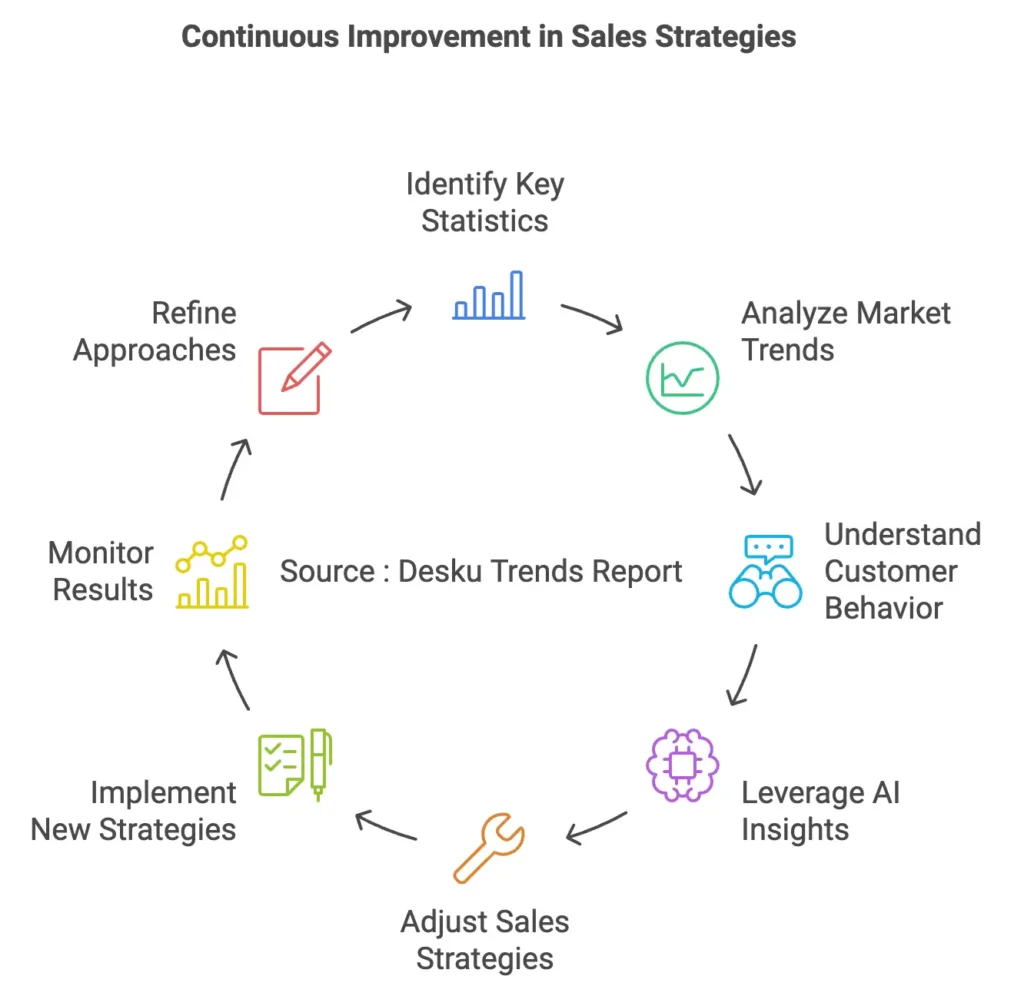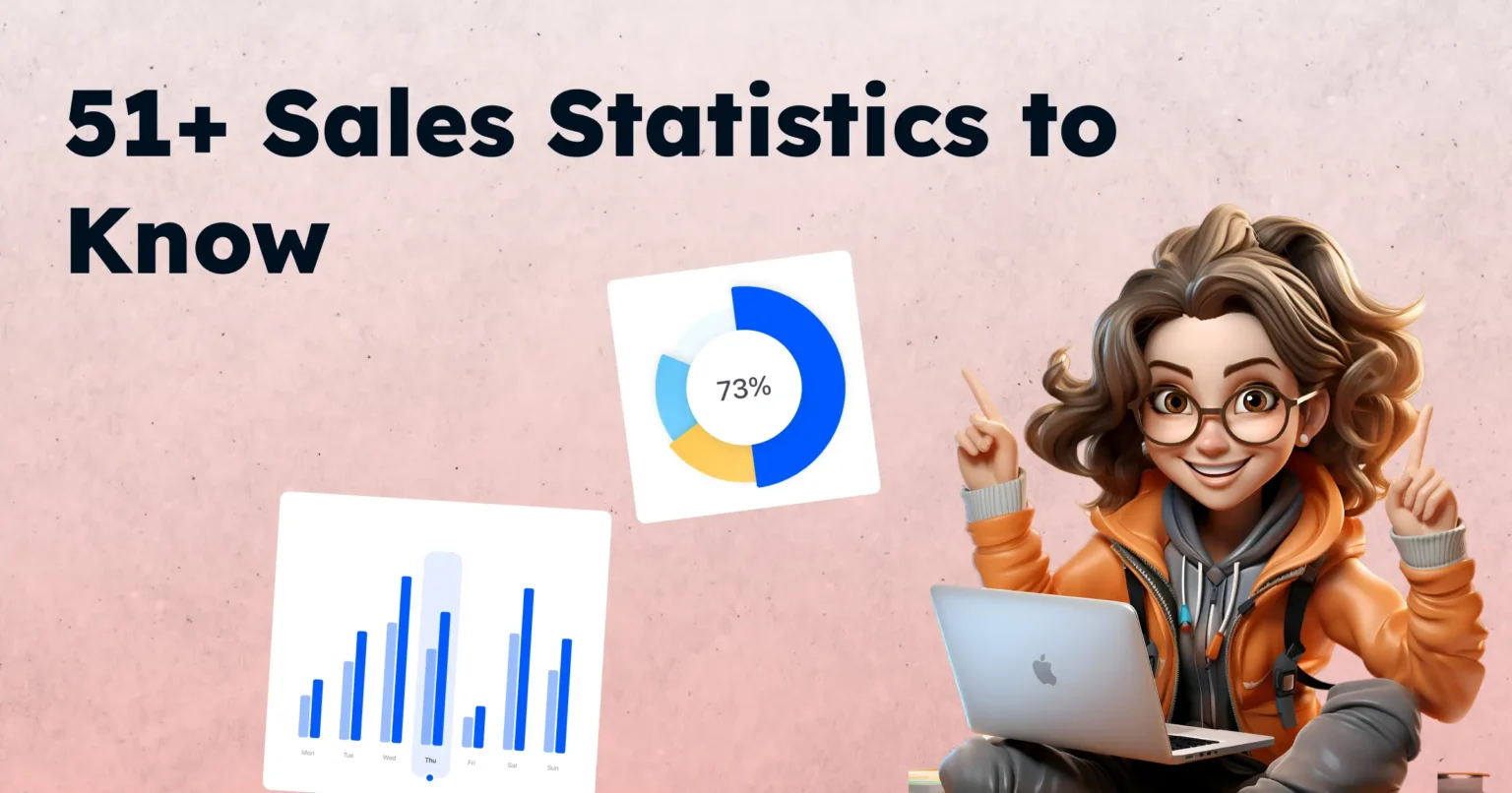Sales leaders are always on the lookout for actionable data to sharpen their strategies. What key statistics should sales professionals know?
Here’s the answer: we’ve compiled 51+ essential sales statistics to help you stay ahead. These stats cover everything from market growth trends to the latest insights into sales productivity, customer behavior, and the impact of AI. Whether you’re a sales manager, executive, marketer, or business owner, this data will guide your decisions and help you adjust your strategies for maximum impact.
But that’s just the beginning. As you dive deeper into these statistics, you’ll uncover emerging trends in remote sales, social selling, and how technology is reshaping the entire sales process. Ready to transform your sales game? Let’s dive into the numbers that matter most.

Sales Statistics for Growth and Market Trends
The world of sales is evolving rapidly, and staying on top of growth and market trends is essential for sales managers and executives planning for the future. Sales growth in 2024 is driven by several key factors, including digital transformation, the rise of e-commerce, and the increasing role of AI in customer interactions. Here are eight key statistics that paint a picture of the sales landscape for 2024:
- Global sales growth is projected to increase by 10%, driven by expanding digital sales channels and e-commerce.
- AI in sales will power 95% of customer interactions by 2025, revolutionizing how companies handle lead generation and customer service.
- 82% of buyers are open to meetings with sellers who proactively reach out, especially when sellers offer personalized and relevant solutions.
- The B2B e-commerce market is expected to grow at a CAGR of 18.7%, showing how crucial digital sales channels are becoming.
- Companies that are first to respond to a lead are 35%-50% more likely to secure the sale. Speed has become a critical factor in converting leads.
- Social selling is on the rise, with 90% of top-performing sellers incorporating social media into their sales strategies.
- In B2B sales, 80% of deals require multiple decision-makers, highlighting the importance of strategic, personalized outreach.
- The use of sales automation tools has grown by 71%, with companies using automation tools seeing significantly higher productivity and deal closure rates.
Sales Team Performance & Productivity Stats
Sales managers and executives know that team performance is crucial for meeting sales goals. Understanding how to optimize team productivity can lead to significant improvements in both revenue and efficiency. Here are eight key statistics that provide insights into sales team performance in 2024:
- Only 35.2% of a sales rep’s time is spent actively selling, with the rest consumed by administrative tasks like data entry and reporting.
- 44% of salespeople give up after just one follow-up call, yet 80% of sales require at least five follow-up calls.
- Sales teams that use automation tools are twice as likely to exceed their sales quotas.
- Top-performing salespeople spend 3-10 hours per week using social selling tools like LinkedIn and Twitter.
- 42.5% of sales reps take 10 months or longer to become fully productive and contribute to company goals.
- High-performing companies are twice as likely to describe their sales processes as highly automated.
- 71% of sales reps report that they spend too much time on administrative tasks, and automating these tasks has been shown to boost productivity by over 66%.
- 90% of sales teams using AI or automation tools in their sales process report higher productivity and improved team performance.
Sales Channels: What’s Working?
Sales channels are evolving, and companies must invest in the right mix of approaches to maximize conversions. Here are eight statistics about the most effective sales channels in 2024:
- Email marketing has a 4.8% conversion rate when sent at optimal times, such as 11 a.m. on Monday mornings.
- Social selling continues to rise, with 74.9% of companies that use social selling seeing their sales teams grow within the next 12 months.
- 50% of sales go to the vendor that responds first, making response time critical.
- 71% of salespeople say LinkedIn is their most important sales channel for B2B prospecting.
- 90% of top-performing salespeople use social media in their sales strategy.
- 82% of B2B buyers expect a personalized experience when interacting with sellers.
- Companies that adopt an omnichannel sales strategy (combining email, social media, and phone calls) report 23% higher conversion rates.
- Cold calling, while challenging, still generates results, with 69% of buyers open to receiving cold calls from new providers.
The key takeaway here is that an integrated, omnichannel approach combining email, phone, and social selling is most effective in 2024. Additionally, being quick to respond is often the difference between winning and losing a sale.
Customer Behavior and Buying Preferences
Understanding how customer preferences are changing is essential to optimizing your sales strategy. Here are eight key statistics on customer behavior for 2024:
- 80% of buyers expect more personalized interactions with sales reps.
- 50% of buyers reject an offer four times before making a purchase, highlighting the importance of persistence.
- 72% of B2B buyers expect sales reps to understand their business needs before making contact.
- 83% of prospects who request information don’t make a purchase for 3-12 months, emphasizing the importance of long-term follow-up.
- 19% of buyers want to talk to a sales rep when first learning about a product, showing the importance of guiding prospects through the early stages.
- Acquiring a new customer costs 5-25 times more than retaining an existing one.
- 84% of C-level executives and 75% of B2B buyers use social media to make purchasing decisions.
- Personalized email campaigns are 26% more likely to be opened by prospects.
Customer expectations are shifting toward more personalized, relevant interactions. Companies that can tailor their outreach to meet these expectations will have a significant edge in the marketplace.
Sales Technology & Automation in 2024
Technology continues to revolutionize the sales industry. Companies that leverage the right tools can see dramatic improvements in efficiency and conversion rates. Here are eight important statistics about sales technology in 2024:
- 95% of customer interactions will be powered by AI by 2025.
- Automation tools have led to a 66% reduction in time spent on non-selling tasks.
- 71% of companies using AI or automation tools report exceeding their sales quotas.
- 90% of top-performing companies use AI-driven solutions to boost sales productivity.
- 45% of salespeople believe that automation and AI will significantly impact their job in the next three years.
- Sales teams using CRM tools see a 29% increase in sales productivity.
- AI-powered tools can increase the number of leads generated by 50%, while reducing lead conversion time by 30%.
- AI-based sales forecasting has improved accuracy for sales teams by 30%, allowing them to plan more effectively.
Sales technology is no longer optional—it’s a must for any company looking to stay competitive. AI and automation tools are proving to be game-changers, increasing productivity, improving lead generation, and reducing time wasted on admin tasks.
Remote Sales and Hybrid Work Statistics
The shift toward remote work is reshaping how sales teams operate. Here are eight statistics on how remote and hybrid work is affecting sales teams in 2024:
- 89% of outside sales reps now spend more time selling remotely than in previous years.
- Remote teams are 13% more productive than their in-office counterparts.
- 50% of sales reps report that they close more deals while working remotely.
- Hybrid work models, which blend remote and office-based work, result in 67% higher quota attainment than traditional models.
- 58% of companies have shifted to hybrid work models.
- Remote sales are projected to account for 50% of all sales interactions by 2025.
- Sales managers report that managing remote teams requires better communication and tracking tools to ensure productivity.
- 90% of sales teams have invested in digital tools to manage remote sales effectively.
The rise of remote and hybrid work is here to stay. Teams that can adapt to this new reality by using the right tools and strategies will see continued success.
Future Sales Predictions for 2025 and Beyond
Looking forward, sales trends continue to evolve. Here are eight predictions and statistics for what the future holds for sales beyond 2024:
- AI will power 85% of sales interactions by 2025.
- Digital and social selling will drive 60% of B2B sales within the next five years.
- 75% of buyers will expect companies to anticipate their needs before making a purchase.
- Companies using data analytics for decision-making will increase their profits by 25%.
- Sales reps using AI-based solutions will see a 50% improvement in lead conversion rates.
- Customer experience will become the key differentiator for sales success, with 80% of companies prioritizing it by 2025.
- Hybrid work models will account for 70% of sales organizations by 2025.
- Self-service sales will rise, with 60% of B2B buyers preferring to research and purchase independently.
The future of sales lies in technology, customer-centric strategies, and hybrid work models. Companies that embrace these trends will be well-positioned for long-term success.


